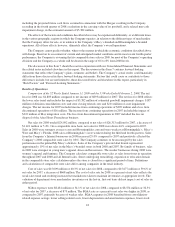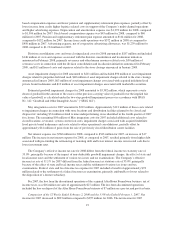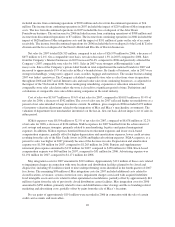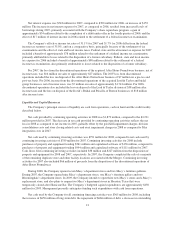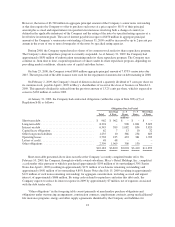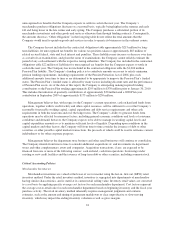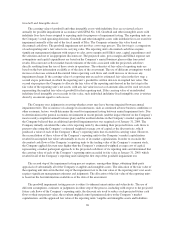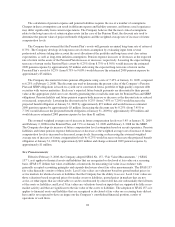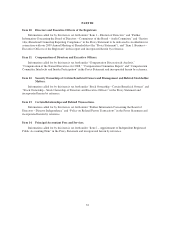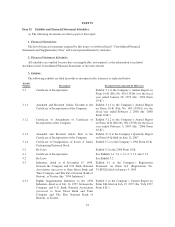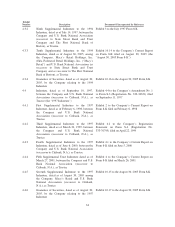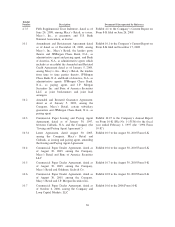Macy's 2008 Annual Report Download - page 34
Download and view the complete annual report
Please find page 34 of the 2008 Macy's annual report below. You can navigate through the pages in the report by either clicking on the pages listed below, or by using the keyword search tool below to find specific information within the annual report.The calculation of pension expense and pension liabilities requires the use of a number of assumptions.
Changes in these assumptions can result in different expense and liability amounts, and future actual experience
may differ significantly from current expectations. The Company believes that the most critical assumptions
relate to the long-term rate of return on plan assets (in the case of the Pension Plan), the discount rate used to
determine the present value of projected benefit obligations and the weighted average rate of increase of future
compensation levels.
The Company has assumed that the Pension Plan’s assets will generate an annual long-term rate of return of
8.75%. The Company develops its long-term rate of return assumption by evaluating input from several
professional advisors taking into account the asset allocation of the portfolio and long-term asset class return
expectations, as well as long-term inflation assumptions. Pension expense increases or decreases as the expected
rate of return on the assets of the Pension Plan decreases or increases, respectively. Lowering the expected long-
term rate of return on the Pension Plan’s assets by 0.25% (from 8.75% to 8.50%) would increase the estimated
2009 pension expense by approximately $5 million and raising the expected long-term rate of return on the
Pension Plan’s assets by 0.25% (from 8.75% to 9.00%) would decrease the estimated 2009 pension expense by
approximately $5 million.
The Company discounted its future pension obligations using a rate of 7.45% at January 31, 2009, compared
to 6.25% at February 2, 2008. The discount rate used to determine the present value of the Company’s Pension
Plan and SERP obligations is based on a yield curve constructed from a portfolio of high quality corporate debt
securities with various maturities. Each year’s expected future benefit payments are discounted to their present
value at the appropriate yield curve rate, thereby generating the overall discount rate for Pension Plan and SERP
obligations. Pension liability and future pension expense both increase or decrease as the discount rate is reduced
or increased, respectively. Lowering the discount rate by 0.25% (from 7.45% to 7.20%) would increase the
projected benefit obligation at January 31, 2009 by approximately $72 million and would increase estimated
2009 pension expense by approximately $5 million. Increasing the discount rate by 0.25% (from 7.45% to
7.70%) would decrease the projected benefit obligation at January 31, 2009 by approximately $70 million and
would decrease estimated 2009 pension expense by less than $1 million.
The assumed weighted average rate of increase in future compensation levels was 5.4% at January 31, 2009
and February 2, 2008 for the Pension Plan, and 7.2% at January 31, 2009 and February 2, 2008 for the SERP.
The Company develops its increase of future compensation level assumption based on recent experience. Pension
liabilities and future pension expense both increase or decrease as the weighted average rate of increase of future
compensation levels is increased or decreased, respectively. Increasing or decreasing the assumed weighted
average rate of increase of future compensation levels by 0.25% would increase or decrease the projected benefit
obligation at January 31, 2009 by approximately $10 million and change estimated 2009 pension expense by
approximately $1 million.
New Pronouncements
Effective February 3, 2008, the Company adopted SFAS No. 157, “Fair Value Measurements,” (“SFAS
157”), as it applies to financial assets and liabilities that are recognized or disclosed at fair value on a recurring
basis. SFAS 157 defines fair value, establishes a framework for measuring fair value in accordance with
generally accepted accounting principles and expands disclosures about fair value measurements. The SFAS 157
fair value hierarchy consists of three levels: Level 1 fair values are valuations based on quoted market prices in
active markets for identical assets or liabilities that the Company has the ability to access; Level 2 fair values are
those valuations based on quoted prices for similar assets or liabilities, quoted prices in markets that are not
active, or other inputs that are observable or can be corroborated by observable data for substantially the full term
of the assets or liabilities; and Level 3 fair values are valuations based on inputs that are supported by little or no
market activity and that are significant to the fair value of the assets or liabilities. The adoption of SFAS 157 as it
applies to financial assets and liabilities that are recognized or disclosed at fair value on a recurring basis did not
have and is not expected to have an impact on the Company’s consolidated financial position, results of
operations or cash flows.
28


